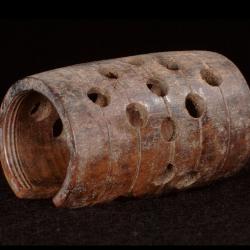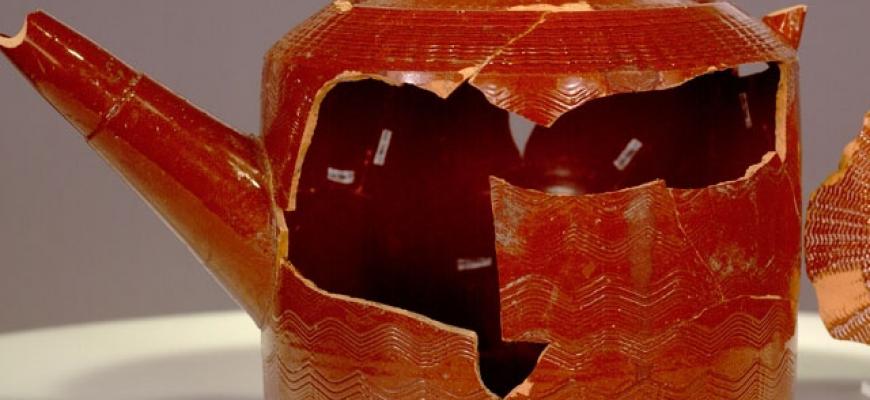Excavations at this site, located east of Dean Street and south of Maiden Lane in Albany, unearthed a French and Indian War stockade line, waterfront bulkheads, and numerous foundations, privies, wells, cisterns, drains, and other features associated with 18th-19th century warehouses, shops, taverns, homes, and boarding houses. There are 176,000 artifacts in this collection. Artifacts within the collection range in date from about 1740 to 1900.
SUCF/SUNY 600 Parking Garage/ State University Construction Fund
- Historical Archaeology
Sub Component

Stewart Deans Lot
The merchant and Revolutionary War hero Stewart Dean owned one of the waterfront lots excavated by archaeologists. After the war, he built a 60-foot sloop, Experiment, which he took on a trading voyage to China in 1785. This was the second vessel from the United States to make the trip to the important trading port of Canton with tar, furs, ginseng, wine, “Jamaica spirits”, tobacco, and other items and Dean returned with tea, silk, and 26 chests of China teacups and saucers. Artifacts from China, such as porcelain, a sandware teapot, and a cricket cage were among the items found at this site along with British and European manufactured goods.
- Stone Collar over Wooden Barrel Well/Privy: 1785-ca.1800, 4,973 artifacts.
- Stewart Dean’s house foundation: 1760-1780, 151 artifacts.
Eights’ Lot
Abraham Eights was born in New York City in 1740s where he was trained as a sail-maker. He moved to Albany in 1769 and was married the following year. He acquired his waterfront lot next door to Stewart Dean in 1775 where he manufactured and mended sails for boats all along the Hudson River as far south as New York City. Eights was among the 94 men who signed the constitution of the Sons of Liberty, in reaction to the passage of the Stamp Act and served in the military during the Revolutionary War, while supplying the Continental Army with sails and provisions. In 1790 his household consisted of 4 white males over 16, 8 females, and two slaves. He was appointed Dock Master in 1812 and continued in this position until his death in 1820 at age 74.
- Privy: 1800-1820, 2,362 artifacts.
Boarding House Privies
The original owner of this waterfront lot was William James, a merchant and grandfather to the well-known author Henry James. In the 1820s, his heirs subdivided the lot into 9 rental properties that shared a large outhouse. Two of these properties were boardinghouses which primarily served transient workers and laborers. The house at 37 Dean Street was run by a widowed German immigrant, Elizabeth Roff, in the 1830s and an Irish immigrant named Philip Duffy from 1855 until 1861. Another Irish immigrant named Thomas Kearnan, operated a boarding at neighboring 35 Dean Street from 1855 until 1865. Occupants of the boardinghouse included European immigrants, especially from Ireland and Germany who arrived between 1830 and 1860. Over 21,000 artifacts were recovered from the two boardinghouse privies, including dominoes, die, a harmonica, glass inkwells, marbles, doll parts, and a cowry shell engraved with a love poem. Also found was a perforated temperance medallion labeled “The STATE OF NEW YORK”.
- The Common Wooden Privy: 1840-1860, 20,668 artifacts.
- The Common Stone Privy: 1830-1840, 918 artifacts.
Other Features and Deposits
- Organic Fill Near Stockade: 1760s, 3081 artifacts.
- Artifact Deposit: 1850s-1900, 181 artifacts.
- Artifact Deposit Associated with the Stockade: 1750s, 221 artifacts.
- Early Stockade Construction: 18th century, 285 artifacts.
- Stockade Surface, Selected contexts: 1740s-1750s, 8338 artifacts.
- Transitional Surface prior to 1760s Stockade Construction, Selected contexts: Pre-1760s, 356 artifacts.
- Waterfront Construction Surfaces, Selected contexts: 1760s, 199 artifacts.
- Surface, selected contexts: 1760s, 129 artifacts.
- River Bottom, Selected contexts: 1760s, 424 artifacts.
- Three Barrel Cistern: ca. 1750, 86 artifacts.
- Archibald Craig’s Cistern: ca. 1840, 857 artifacts.
- Christopher Beekman’s Privy: 1800-1810, 1,897 artifacts.
- Widow Benedict’s Privy: 1800-1820, 589 artifacts.
- John Tayler’s Privy: 1800-1820, 1517 artifacts.
- The Lemet-Olmsted Privy: 1810-1820, 100 artifacts.
- Allen Brown’s Privy: 1815-1830, 9,651 artifacts.
- Cowan and Cobb’s Privy: 1820-1830, 2,024 artifacts.
- Possible Stone Lined Privy: 1850-1900, 1,162 artifacts.
- Brick Drain: 19th century, 80 artifacts.
- Wooden Drain: ca. 1760, 152 artifacts.
- Possible Midden: 19th century, 1,474 artifacts.
- Quoin support for waterfront bulkhead: 1760s, 1,537 artifacts.
- Possible Midden: 1850-1900, 58 artifacts.
- Pit Feature: 1850-1900, 392 artifacts.
- Stacked Rigging for waterfront bulkhead: 1780s, 15 artifacts.
- Vertical-pile Waterfront Bulkhead: 1780s, 566 artifacts.
- Fill Deposit in Waterfront Bulkhead: 1760s, 324 artifacts.
- Wooden Stockade: 1750s, 2,154 artifacts.
- Early Waterfront Bulkhead: 1750s, 129 artifacts.
- Waterfront bulkhead Feature: 1760s, 53 artifacts.
- Builder’s Trench for Stockade: 1750s, 31 artifacts.
- Fill and Building Debris within the Demilune: 1750s, 358 artifacts.
- Wooden Feature Possibly Associated with Demilune: 1750s, 702 artifacts.
- Planks for building foundation: 19th century, 487 artifacts.
- Possible Drain through the Stockade: 1750s, 292 artifacts.
- Stone Building Foundation: 1870s, 84 artifacts.
- Early Waterfront Bulkhead: 1750s, 66 artifacts.
- Dog Burial: 1750s, 372 artifacts.
- Cobblestone fill within the Demilune: 1750s, 3,934 artifacts.




